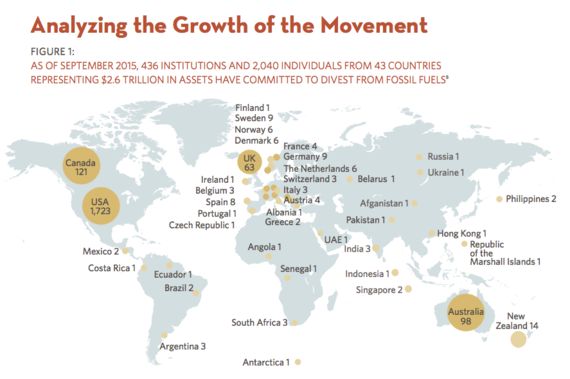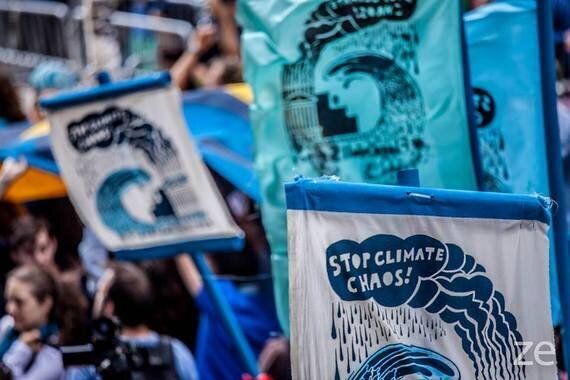
Building on the momentum generated by Climate Week and the New York People's Climate March at this time last year, divestment advocates made an ambitious announcement: a plan to triple the $50 billion in assets individuals and organizations had pledged to divest from fossil fuels by the time of the 2015 Paris UN climate negotiations.
That was an ambitious plan.
But in the year since, according to a new report from Arabella Advisors, the divestment movement exploded in scope and scale increasing fifty-fold, bringing the total combined assets of those divesting to an incredible $2.6 trillion.
It's safe to say that no one, not even the most optimistic divestment dreamers, could have anticipated this outcome.
So, what's behind the global momentum for divestment?
Climate Change Means Financial Risk
This exponential growth has, in part, to do with the increasing awareness that climate change means financial insecurity.
The risk to investment comes mostly in the form of what are called stranded assets: those fossil fuel reserves that will not be exploited due to efforts to limit climate change.
As Arabella Advisors notes in its new report, concerns about stranded assets and the devaluation of fossil fuels in a carbon constrained world has been a focus of powerful financial institutions such as Citigroup, HSBC, Mercer, the International Energy Agency, the Bank of England, as well as the respected Carbon Tracker Initiative which pioneered analysis on "unburnable carbon."
HSBC warned investors the movement of investment dollars to the clean energy sector could mean fossil fuel companies will be worth much less in the future.
It turns out investors are realizing that divestment doesn't mean financial losses. Thanks in part to plummeting global oil prices and the booming clean energy economy, divested portfolios have been outperforming those with investments in fossil fuels.
Climate change also increases the risk to investments by destabilizing the climate, meaning more extreme weather bringing storms or wildfires that, in turn, flood cities or destroy homes. Many international insurance groups have also warned that climate change threatens the value we hold in all kinds of assets.

A large "carbon bubble" on Wall Street during the 2014 Flood Wall Street event. Photo: Zack Embree.
Divestment Movement Full of Unusual Suspects
If you think divestment is for dogged climate activists, think again.
What the explosion of the divestment movement shows is, far from attracting a small group of political lefties, divestment has been taken very seriously by pension funds and private companies.
At this time last year, Arabella notes the divestment movement relied on the support of NGOs, foundations, student-led movements on university campuses and other "mission-driven organizations" like climate advocacy groups.
Now, amazingly, over 95 per cent of the assets committed to divestment are held by large pension funds and private-sector businesses like insurance companies.
But that doesn't mean those original divestment groups aren't still growing the movement.
In June 2015 Pope Francis released his encyclical, making a strong moral argument for climate action. Faith organizations represent $24 billion in divestment assets.
Universities are also steadily joining the divestment movement. In the last year, university divestments have tripled and major institutions like the University of California, which holds a $98-billion portfolio, are joining on.
In addition, local governments and public pensions are also building the divestment movement. For example, earlier this month the California General Assembly voted to divest its $476-billion public employee pension fund from companies generating 50 per cent or more of their revenue from the coal industry.
Finally, major foundations from around the world are also divesting, recognizing and redirecting their investments can be used as a powerful tool for achieving their organization's mission. So far, Arabella reports 116 foundations have pledged to divest a shared $10 billion in assets.

Global Divestment Movement. Image: Arabella Advisors.
Divestment Has Gone Global
Divestment is no longer a U.S. preoccupation.
In 2014, 78 per cent of divesting institutions were based in the U.S., according to Arabella. Today, only 57 per cent of these institutions are based in the U.S. with divestment hot-spots popping up all over the globe.
Notably, Canada is second after the U.S. as a leader in divestment.
Altogether, the estimated 436 groups supporting divestment represent more than 646 million individuals worldwide.

Signage from the 2014 Flood Wall Street event. Photo: Zack Embree.
Clean Energy is All the Rage
Divestment doesn't just mean pulling your investments from fossil fuel holdings -- it also means redirecting investment dollars to alternatives like clean energy, green tech and climate solutions.
In 2014, investment in clean energy skyrocketed to $310 billion globally.
That number is expected to continue growing with an estimated $785 billion in divested assets being pledged to finding climate solutions.
Bill Gates personally pledged to invest $2 billion in renewable technologies, saying "in addition to mitigating climate change, affordable clean energy will help fight poverty."
Although companies like the coal monolith Peabody Energy argue fossil fuels are necessary to bring electricity and opportunity to developing nations, the divestment movement is working to bring clean and renewable energy directly to these places in a move that skips right over highly polluting energy sources (this is known as leapfrogging).
And this makes a lot of sense, given renewable energy is now cost-competitive with fossil fuels and much more popular. Renewable energy is seen as the most effective way to both reduce and alleviate poverty in many countries while simultaneously working to cool the climate.
Arabella concludes that the divestment movement shows political leaders that the world is more ready for meaningful climate action than perhaps previously realized.
In December nations will meet in Paris to sign a global climate agreement. The Arabella report shows that leaders have the political cover needed to take bold steps at this important meeting.
But also, perhaps most significantly, the report shows that despite what the top leaders of the world decide, the momentum behind the divestment and climate movement is likely to continue on regardless.
MORE ON HUFFPOST:
